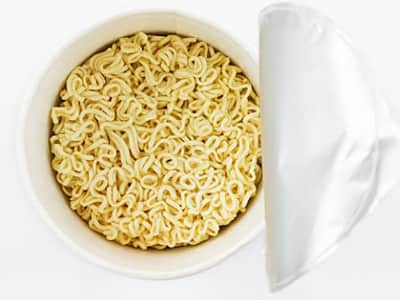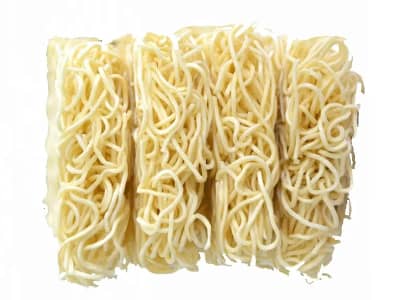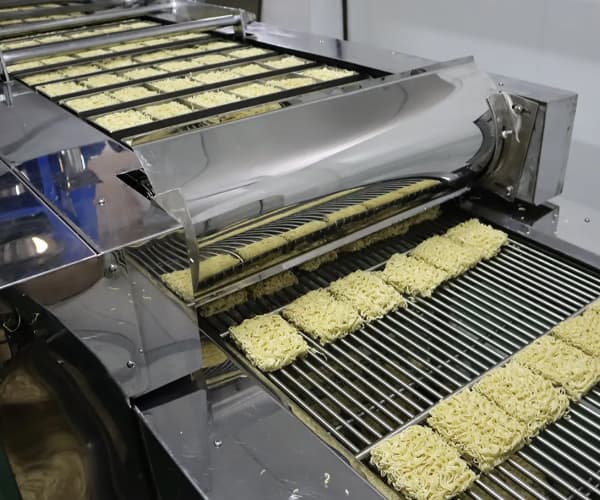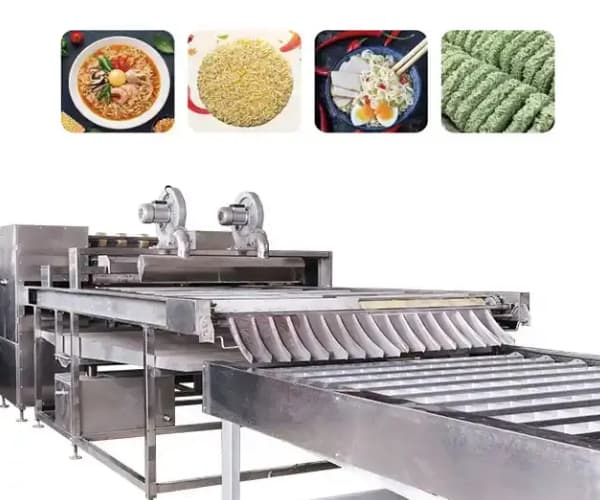Pengenalan: Mengapa mi segera penting
Mie segera adalah salah satu produk makanan yang paling ikonik dan dimakan di dunia. Cepat, murah, dan memuaskan, Mereka berfungsi sebagai makanan ruji di seluruh Asia, Afrika, Eropah, dan Amerika. Sama ada snek tengah malam pelajar atau makanan pengembara, mi segera telah merevolusikan penggunaan makanan global.
Artikel ini menawarkan menyelam yang mendalam ke dalam jenis, proses pembuatan, pembungkusan, pemakanan, dan evolusi mi segera-dari permulaan yang rendah di Jepun untuk menjadi industri berbilion dolar.

1. Asal dan kenaikan mi segera global
1.1 Ciptaan mi segera
Mi segera dicipta di 1958 oleh Momofuku Ando, Pengasas Nissin Foods di Jepun. Produk pertamanya, "Ramen ayam," Adakah kek mi goreng minyak yang dibungkus dengan perasa.
Dalam 1971, Dia melancarkan pertama di dunia mi cawan, Mengubah cara mi dimakan - hanya memerlukan air panas dan beberapa minit untuk menyediakan.
1.2 Mi segera di seluruh dunia
Mi segera cepat menjadi popular di seluruh dunia kerana mereka:
- Jangka hayat panjang
- Kos yang berpatutan
- Masa penyediaan minimum
Hari ini, Penggunaan global melebihi 120 bilion hidangan setahun, Menurut Persatuan Mie Segera Dunia (Yang lain).
2. Jenis mi segera
2.1 Dengan kaedah pemprosesan
| Jenis | Penerangan |
|---|---|
| Mi segera goreng | Goreng dalam dehidrasi dan rasa; tekstur rangup |
| Mi segera bukan goreng | Udara kering atau dikukus; Lemak yang lebih rendah, alternatif yang lebih sihat |
| Mi siap kukus | Mi basah yang dijual dalam bentuk peti sejuk; biasa dalam ramen segar |
2.2 Dengan format pembungkusan
| Jenis pembungkusan | Perincian |
|---|---|
| Mi mi | Format tradisional, Memerlukan mangkuk atau periuk |
| Mi cawan/mangkuk | Datang dalam bekasnya sendiri, Tambah sahaja air panas |
| Dulang microwave | Dibungkus untuk pemanasan dan penggunaan gelombang mikro |
2.3 Oleh rasa dan wilayah
| Wilayah | Perisa tandatangan |
|---|---|
| China | Sup daging lembu, sayur -sayuran jeruk, daging babi pedas |
| Jepun | Tonkatsu, Saya willow, Miso Ramen |
| Korea | Kimchi, mi api keju, Rebusan tentera |
| Asia Tenggara | Tom Yum, Laksa, Udang, Lime masam |
| Pasaran Barat | Ayam berkrim, Rebus daging lembu, bacon & keju |

3. Proses pembuatan mi segera
3.1 Bahan asas
- Tepung gandum atau tepung beras
- Ejen garam dan alkali
- Air
- Minyak sayuran (untuk menggoreng)
- Aditif: Vitamin, Penambah rasa, pewarna
3.2 Peringkat pengeluaran (Untuk mi goreng)
- Pencampuran doh - Bahan -bahan yang diukir ke dalam adunan yang konsisten
- Lembaran & Bergulir - Doh digulung ke dalam lembaran nipis
- Mengukus - dimasak melalui stim untuk berisi kanji
- Memotong & Melambai - Dibentuk ke dalam helai keriting
- Menggoreng -Dehidrasi oleh minyak sawit yang mendalam pada ~ 160 ° C
- Penyejukan - Udara disejukkan ke suhu bilik
- Penyediaan pek perasa - serbuk rempah, Sos, sayur -sayuran
- Pembungkusan - Pengedap automatik dalam beg, cawan, atau mangkuk
Mi yang tidak digoreng melangkaui panggung yang menggoreng dan melalui pengeringan lanjutan di terowong udara panas.
4. Pembungkusan dan kehidupan rak
Pembungkusan memainkan peranan penting dalam keselamatan mi segera, Kesegaran, dan kemudahan pengguna.
4.1 Jenis pembungkusan
| Jenis | Faedah |
|---|---|
| Pek bantal plastik | Murah, Cepat untuk menghasilkan |
| Cawan kertas dengan penutup foil | Selamat microwave, Mudah-mudahan on-the-go |
| Pek foil aluminium | Jangka hayat yang lebih lama, pengekalan aroma |
| Eco-packaging (Kertas/Filem Biodegradable) | Mampan, Pilihan yang boleh dipasarkan |
4.2 Kehidupan rak
- Mi goreng: 6-12 bulan
- Mi bukan goreng: 3-6 bulan
- Sachet perasa mungkin termasuk penyerap oksigen untuk umur panjang

5. Pertimbangan pemakanan dan kesihatan
5.1 Profil pemakanan
Hidangan mi segera yang biasa mengandungi:
- Karbohidrat: 40-60g
- Lemak: 12-20g (kebanyakannya dari menggoreng)
- Natrium: 800-1800mg (selalunya tinggi)
- Protein: 6-10g
5.2 Kesilapan kesihatan
Mitos: "Mie segera tidak sihat."
Realiti: Kesederhanaan adalah kunci. Banyak produk moden adalah:
- Bukan goreng dan rendah lemak
- Diperkuat dengan vitamin (B, D, besi)
- Dibuat dengan gandum keseluruhan, quinoa, atau tepung oat
- Ditawarkan dengan pilihan rendah sodium atau msg
5.3 Tambahan yang sihat
Untuk meningkatkan pemakanan, tambah:
- Telur rebus
- Sayur segar atau beku
- Tauhu, ayam, atau ikan
- Kimchi, Rumpai laut, atau biji bijan
6. Trend pasaran dan keutamaan pengguna
6.1 Pasaran Global
- Asia Pasifik adalah pangkalan pengguna terbesar
- Afrika dan Amerika Selatan adalah pasaran yang paling pesat berkembang
- Pendapatan global dianggarkan melebihi USD 50 bilion oleh 2030
6.2 Trend Pengguna
- Mi cawan semakin popular di kalangan pemuda bandar
- Permintaan untuk pilihan vegan/gluten bebas semakin meningkat
- Pertumbuhan dalam Ramen Premium dengan topping daging sebenar
- Peningkatan dalam Kotak langganan mi segera dalam talian

7. Jenama mi segera teratas (2024)
| Pangkat | Jenama | Negara |
|---|---|---|
| 1 | Nissin | Jepun |
| 2 | Master Kong | China |
| 3 | Samyang | Korea Selatan |
| 4 | Nongshim | Korea Selatan |
| 5 | Indomie | Indonesia |
| 6 | Maggi | Switzerland |
| 7 | Mama | Thailand |
| 8 | A-sha | Taiwan |
| 9 | Acecook | Vietnam |
| 10 | Mi anak patung | Hong Kong |
8. Inovasi dalam industri mi segera
- Garisan pembungkusan AI-bersepadu dengan pengesanan kualiti masa nyata
- Teknologi Mi Minyak Rendah dan Udara Udara
- Mi segera berasaskan tumbuhan (kacang, Chickpea, tepung lentil)
- Eco-packaging yang boleh dimakan (Filem rumpai laut)
- Kotak mi segera pemanasan sendiri untuk pasaran luaran
- 3D-dicetak bentuk mi dan pek pemakanan yang diperibadikan
9. Mi segera dan kesan budaya
- Dalam Korea Selatan, Mie segera adalah ikon budaya, sering dipasangkan dengan kimchi dan dipaparkan dalam drama k.
- Jepun Malah dilancarkan "Ramen Space" untuk angkasawan di atas ISS.
- Dalam China, perjalanan kereta api dan mi segera tidak dapat dipisahkan.
- Nigeria dan India bergantung pada mi sebagai makanan harian yang murah, Terutama untuk pelajar dan pekerja.
Kesimpulan: Mi segera - lebih daripada sekadar makanan ringan
Mie segera adalah gabungan sains yang cemerlang, kemudahan, dan budaya. Sama ada dihasilkan secara besar-besaran Barisan Pengeluaran Perindustrian atau dinikmati di pondok gunung terpencil dengan termos air panas, mi segera kekal relevan, berkembang, dan kekasih.
Kesesuaian mereka - dalam bentuk, rasa, dan fungsi - menjadikan mereka salah satu produk makanan yang paling kekal yang pernah dibuat.
